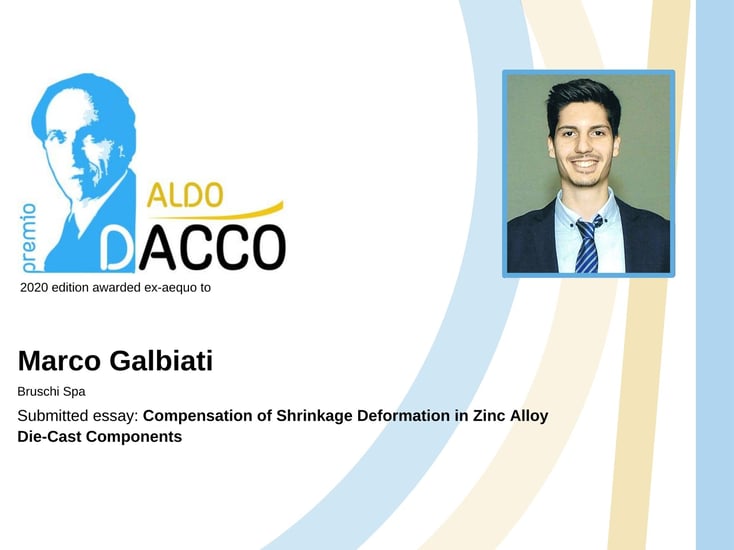Marco Galbiati awarded with the 2020 Aldo Daccò Prize

Bruschi are pleased to announce that our colleague Engr. Marco Galbiati – mechanical designer at Bruschi Spa – was awarded with the 2020 Aldo Daccò Prize on January 18th, 2021.
Also this year, the Association of Italian Metalworkers (Associazione Italiana di Metallurgia – AIM) launched its 2020 Aldo Daccò Prize. The award was first established in 1975 to stimulate the sector’s technicians to contribute to the progress of foundry and solidification techniques through essays and original studies. Due to the restrictions in force, the award ceremony was held online on January 18th, 2020 on the occasion of the opening ceremony of the 38th AIM national congress.
In the 2020 edition of the Aldo Daccò Prize, Marco was awarded ex-aequo with Engr. Lavinia Tonelli and presented the scientific paper Compensation of Shrinkage Deformation in Zinc Alloy Die-Cast Components.
We interviewed him to learn more about his paper and compliment him on the great result obtained.
Tell us something about the contest you participated in - what is it and why did you decide to compete?
AIM is a non-profit cultural body and was founded in January 1946 with the aim of spreading the science and technology of metallic and other engineering materials. In the wake of its mission, AIM has been organizing this competition for 45 years. I have always followed it for personal interest and I have been looking forward to participating in it for a long time. Having worked at Bruschi Spa for the last few years, I decided to combine my technical knowledge and the experience developed in the field to contribute to the development of the knowledge of foundry and solidification techniques.
What does your paper deal with?
The paper presented is entitled: Compensation of Shrinkage Deformations in Zinc Alloy Die-Cast Components. In particular, it focuses on a specific criticality of zinc alloy die casts, i.e. the occurrence of product deformations caused by the shrinkage of material in the post-molding phase. In the paper I highlighted the difficulties encountered and the possible methods of solving this problem.
Why did you decide to develop precisely this topic?
The problems dealt with in my paper emerged during the inspection of particular products at Bruschi Spa. These problems were first discovered by our Quality Engineer Andrea Salmistraro. During the component analysis phase (performed with a 3D scanner), he noticed that some important dimensions were altered by a defect due to alloy deformation. Thanks to the involvement and contribution of our Strategic Technology Manager Ermo Fusè we hypothesized and subsequently demonstrated that this defect was related to shrinkage caused by Zamak solidification, which varies depending on mass distribution in the component. With my paper I intended to demonstrate that our solution makes it possible to counteract shrinkage deformations of material.
How did you get to the solution?
The first step was to verify that the mold did not have any alterations that could lead to this problem. Once the suitability of molds and sliders was ascertained, we analyzed two practical cases in which the components presented the same problem – despite their clearly different geometric characteristics:
- Flat surface deformation: in this case we started by scanning the deformed piece. Thanks to a CAD software, we extrapolated a lattice and used it to digitally reconstruct the deformed surface and then symmetrize it to obtain a counter-deformed surface. Finally, we applied this surface to the corresponding molding insert surface in order to obtain a piece deformed in the opposite direction and – once cooled – a compliant die cast.
- Cylindrical surface deformation: we followed a procedure similar to the previous one, even if it was not possible to replicate and symmetrize the deformed surface due to geometry complexity. We then scanned the pieces to identify the deformed areas and – after delimiting them with our CAD software – we projected them directly onto the molding insert surface and lastly we counter-deformed them.
Your paper suggests that the deformations addressed are in the order of tenths or even hundreds of a millimeter – how did you guarantee the finish’s precision?
Thanks to his many years of experience and in-depth knowledge of the equipment, our CAM toolmaker and programmer Matteo Annovazzi was able to faithfully replicate the design. He created an accurate CAM program for the milling machine and he then used it to work the molds.
What do you think of this experience and of your victory?
I am very satisfied with the result. I am proud of the existence of entities committed to promoting progress, the exchange of ideas and the sharing of knowledge in this sector. I would also like to thank Bruschi Spa for allowing me to carry out the studies shown in this paper and the support received from the entire team. It is thanks to the collaboration of the various engineers and technicians of the Bruschi team that I was able to demonstrate that it is possible to counteract the deformations caused by material shrinkage by means of a voluntary and targeted counter-deformation of the molding insert surface that generate the surfaces affected by this problem. It is not my victory – it is a team victory.
